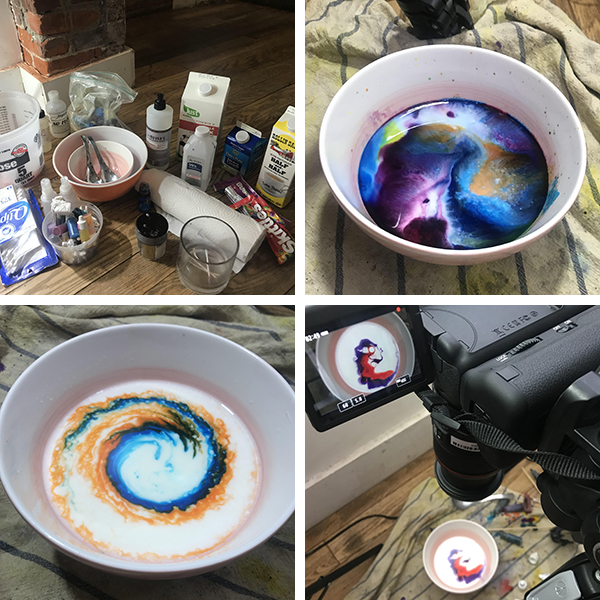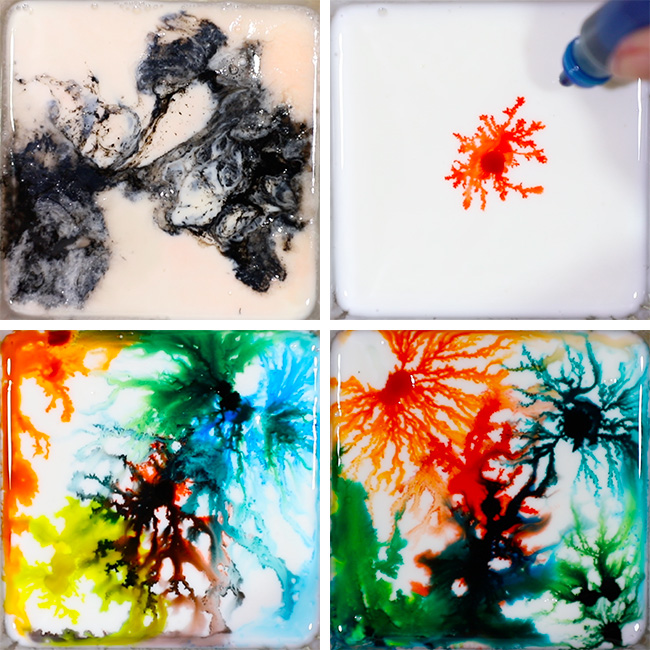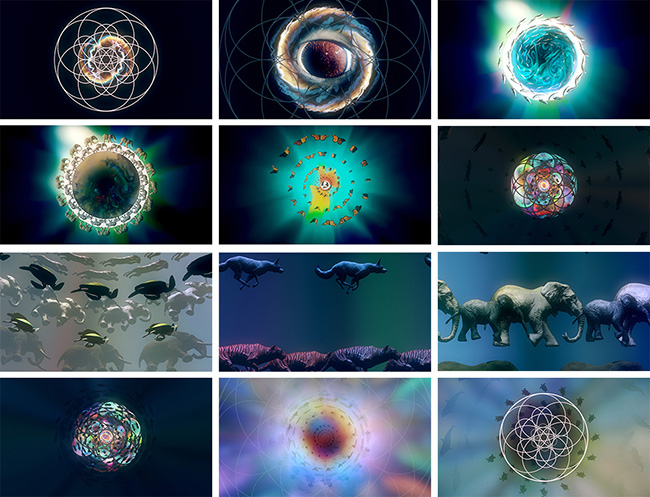In this essay, composer Sarah Kirkland Snider shares the story of (and behind-the-scenes photos from) her collaboration with video designer Deborah Johnson / CandyStations on Mass for the Endangered. The Mass, with a libretto by poet/writer Nathaniel Bellows, is a celebration of, and an elegy for, the natural world, an appeal for greater awareness, urgency, and action. The recording, on which the English vocal ensemble Gallicantus performs the piece, is due September 25. 'Sanctus/Benedictus,' from the piece, is available now, as is Johnson's video for it.
In this essay, composer Sarah Kirkland Snider shares the story of (and behind-the-scenes photos from) her collabortion with video designer Deborah Johnson / CandyStations on Snider's Mass for the Endangered. The Mass, with a libretto by poet/writer Nathaniel Bellows, is a celebration of, and an elegy for, the natural world—animals, plants, insects, the planet itself—an appeal for greater awareness, urgency, and action. The recording, on which the English vocal ensemble Gallicantus performs the piece, is due September 25 on New Amsterdam / Nonesuch Records. 'Sanctus/Benedictus,' from the piece, is available now, as is this video for it created by Johnson.
I had been an admirer of Deborah’s work for a long time—her collaborations with Sufjan Stevens, eighth blackbird, and the Dessner/Muhly/Stevens project Planetarium had all greatly impressed me. But it was her haunting video for the Alarm Will Sound recording of Donnacha Dennehy’s ‘Keening’ from The Hunger that inspired me to e-mail her out of the blue last year about Mass for the Endangered. I was deeply moved by its strange, sorrowful beauty and the way she visually connected the suffering of one individual to that of many generations through a very poetic use of neuronal maps. Fortunately for me, Deborah is a fellow animal lover: despite a busy slate of projects, she said yes.
Deborah and I spoke in-depth about the meaning and intent behind Mass for the Endangered. I explained that librettist Nathaniel Bellows and I had sought to use the traditional Catholic Mass as a prism through which to worship, celebrate, and eulogize endangered animals and the imperiled environments in which they live. As with the Catholic Mass, Mass for the Endangered embodies a prayer to a higher power—for mercy, forgiveness, and intervention. But where the Catholic Mass pleads to a God conceived in the image of man, our Mass pleads to Nature itself. Four of the six movements are written in Nathaniel's secular prose, but in preserving the traditional expressive function of each movement, and in using the traditional Latin text for two movements (and weaving bits of Latin throughout the rest), we were not shying away from allusions and references to the Catholic tradition—and as Deborah and I discussed, neither should she. I sent her the libretto and the cover art Nathaniel had created for the album, which featured a triptych of hand-drawn endangered animals in the style of a medieval Christian altarpiece.
A few days later, Deborah sent me the following storyboard outline of her vision for 'Sanctus/Benedictus,' the first “single” we planned to release from the album:
Evolving from an eye of a universal rosette window, a menagerie of endangered animals ascend to the heavens through light, color, and divinity. Eye, navel, window—every aperture coalescing and transforming into a portal to celestial existence.
I. Heaven/Lumia
We begin with light, synesthetically oscillating with tones in the music. It draws across dimensions creating various light forms, alluding to the essence and creation of life. Its patterns reference sacred geometry, astronomy, astrology.
II. Earth/Evolve
Animal eyes begin to crystallize, starting with fish, reptile, and so on. The final iris fuses into a phylogenetic tree—setting off a spiraling evolution. As the tree begins to spin, its roots and stems morph into a sequence of endangered animals, chased by iconic, global disasters.
III. Glory/Ascend
The animals continue to animate, building a multi-dimensional menagerie. Their bodies raise to form an ascending, spiral castle, escaping this mortal coil into a loving universe.
In explaining these ideas, Deborah referenced things like bio/sacred geometry, cycle/phased based animations (phenakistoscopes and zoetropes—pre-film animation devices that created a fluent illusion of motion), phylogenetic trees (diagrams that represent evolutionary relationships among organisms), the Aoi spiral castle (from Japanese Manga), and the observable universe. She even sent me this clip of Carl Sagan talking about evolution. She had so many great ideas—I was deeply intrigued, and thought to myself: “it’s a shame we can’t create a video for every movement.” It was clear there was a whole world of visual companionship for the Mass to be explored through her eyes.
Then COViD-19 hit. As reality set in that performances of choral music wouldn’t be happening in this country for a long time, I realized there was a silver lining: we could take the funds we’d set aside to help support live performances of the Mass and invest them in the creation of these videos. It would likely mean needing to raise that support again later whenever we could perform the Mass live, but I decided to Worry About That Later. For many reasons, it felt like the (observable) universe was saying this was the way to go.
So, now, here we are: the video for ‘Sanctus/Benedictus’ was released July 8, Deborah is hard at work on the next (to be announced soon!), and beyond that are four others to come. The overarching concept for the full set of six videos is a kind of ‘Cathedral of the Cosmos,’ a Gothic Cathedral-inspired final resting place in the beyond, honoring and receiving the animal and plant species that no longer find life on Earth sustainable. Each movement will be “drawn” from the point of view of an architectural feature of this imagined Cathedral in the heavens—stained-glass windows, altarpieces, and so on. The style of animation for the videos will begin relatively simply in the first and become more developed as the movements progress: from hand-drawn to vector to 3D, etc. By the time we reach ‘Agnus Dei,’ the final movement of the piece, all six movements’ windows/features/points of view will be represented, revealing the totality of the Cathedral of the Cosmos, eternal home for endangered Earthbound flora and fauna.
One of my favorite aspects of this collaboration has been learning about Deborah’s creative process and getting to peek behind-the-scenes at how she makes her art. For this project, she is working with hand-made or hand-drawn content that she then manipulates digitally. In the case of the lushly colorful, rosette-window universe of ‘Sanctus/Benedictus,’ some of Deborah’s CGI creations began life as organic admixtures of cream and candy. Skittles, half & half, heavy cream: all of the materials on the table in the accompanying photo were used to make these swirling clouds of color—with varying degrees of ratios, applicators, and agitators. Basically, it’s food coloring added to non-dairy/dairy bases and “activated” by adding drops of dish soap. Which Deborah then photographs and records with a large, microscope-looking camera and digitally manipulates into CGI (which I had to look up, by the way, because I’ve never really known that it stands for Computer-Generated Imagery—which somehow seems disappointingly tautological?) The orange and blue spiral in the bowls in these shots later becomes the animal “eye” we see circa 1:08 in the video.

In addition to the animation's source content being analog-based, the methodology behind the CGI for ‘Sanctus/Benedictus’ was based on analog concepts—like the phenakistoscope and the zoetrope (as mentioned earlier, these were nineteenth-century animation devices.) The motion of the marching animals in ‘Sanctus/Benedictus’ was inspired by those mechanisms; their iterations were paced and spaced at a specific distance/speed to give the illusion of movement. As Deborah says, “I was drawn to the idea of cycles giving life to otherwise frozen forms.”
Here are some "before" photos of Deborah’s source content in-process:

And here are some "after" stills from the video for ‘Sanctus/Benedictus’:

Deborah obviously has a very intuitive sense of music, which is why her work is favored by so many musicians—I was really struck by the thoughtfulness and sensitivity with which her animations inhabit the architecture and pacing of the score. In the case of a few spots where I wanted to visually emphasize something specific in the music, she was always open to trying, and quick to come up with a better idea than anything I could have imagined. What resulted in 'Sanctus/Benedictus' is a visual journey that actually changed the way I hear the music—which after months of obsessive editing, mixing, and mastering (after years of writing and revising), is amazing and thrilling.
Working with Deborah on Mass for the Endangered has been one of the more satisfying and enriching collaborations I’ve experienced. I love that I don’t know what’s next to come in this poetic, layered, phantasmagorical story she’s creating, and I can’t wait to see how it expands and deepens my understanding of the music.
- Log in to post comments



